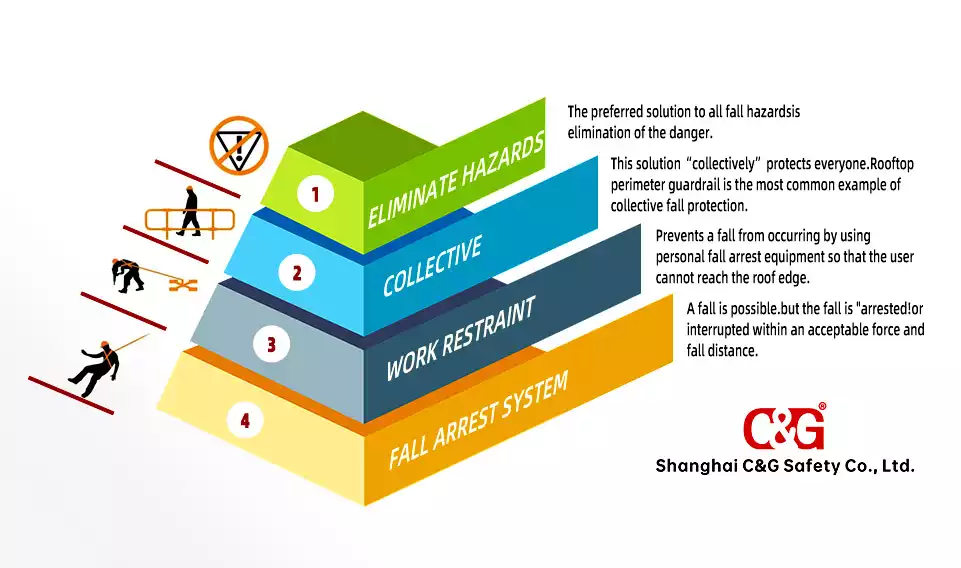Shanghai, China
+86-17317656853
inquiry@cgprotection.com



Eliminating fall hazards is the most effective way to protect workers from falls in the workplace. This can be achieved by changing the work process or by installing protective systems such as scaffolds or barriers. While this may not always be feasible or cost-effective, it should always be considered as the first line of defense against falls. By eliminating the hazard, workers can perform their tasks safely without the need for additional fall protection measures. Employers should prioritize the elimination of fall hazards in their workplace to ensure the safety and well-being of their employees.
Collective fall protection systems are the second most effective solution for protecting workers from falls. These systems are designed to protect all workers at once, without requiring any action on their part. Examples of collective systems include railings, barriers, and safety nets. These systems are passive, meaning they do not require any input or action from the user. Collective systems are effective because they eliminate the need for workers to make decisions about fall protection, reducing the risk of human error. Employers should consider implementing collective fall protection systems in their workplace to provide effective and efficient protection for their workers.
If elimination or collective systems are not feasible, employers should consider work restraint as a fall protection solution. Work restraint involves the use of personal fall arrest equipment such as harnesses, lanyards, and anchor points to prevent workers from reaching the edge and falling in the first place. However, work restraint may restrict workers from performing certain tasks or accessing certain areas, making it an impractical solution in some situations. Employers should carefully evaluate the work environment and the tasks involved to determine whether work restraint is a viable option for fall protection. When implemented correctly, work restraint can provide an effective solution for preventing falls in the workplace.
It is important to note that fall arrest should only be considered as a last resort when all other options are not feasible. While fall arrest can prevent a worker from falling to their death, it is the least desirable option due to the potential for equipment failure, user error, and injuries sustained during the fall. A rescue plan must be in place in case of a fall, and workers must be trained in the proper use of fall arrest equipment. Even with rescue devices available to alleviate suspension trauma, there is still a risk of serious health issues or death if a worker is not rescued quickly. Employers should prioritize the elimination or use of collective or work restraint fall protection systems before considering fall arrest as a solution.
Employers should also ensure that fall arrest equipment is properly maintained and inspected regularly to minimize the risk of equipment failure. Workers should be trained in the proper use of fall arrest equipment, including how to properly fit and adjust harnesses, how to choose appropriate anchor points, and how to inspect equipment for signs of wear or damage. Employers should also have a rescue plan in place and provide training to workers in rescue procedures. Workers should know how to call for help and be aware of the potential hazards associated with suspension trauma.
In summary, while fall arrest is the least desirable option for fall protection, it is still a necessary option in some situations. Employers should prioritize the elimination or use of collective or work restraint fall protection systems before considering fall arrest. If fall arrest is the only feasible option, employers must ensure that the equipment is properly maintained and inspected, workers are trained in its use, and a rescue plan is in place.
Tags:
Shanghai C&G's personal protective clothing and PPE products are trusted by customers in the world. Our products are exported worldwide, with a strong presence in the United States, China, Japan, Germany, the United Kingdom, India, France, Italy, Brazil, and Canada. In addition, we have a significant customer base in other countries across each continent, including Australia, New Zealand, South Africa, Nigeria, and Egypt in Africa; Argentina, Chile, and Mexico in South America; Russia, South Korea, and Indonesia in Asia; Spain, Poland, and Turkey in Europe; and Saudi Arabia and the United Arab Emirates in the Middle East. Wherever you are in the world, we have the products you need to stay safe and protected. Contact us today to learn more about our products and how we can help you meet your safety needs.










© 2023 Shanghai C&G. All Rights Reserved.